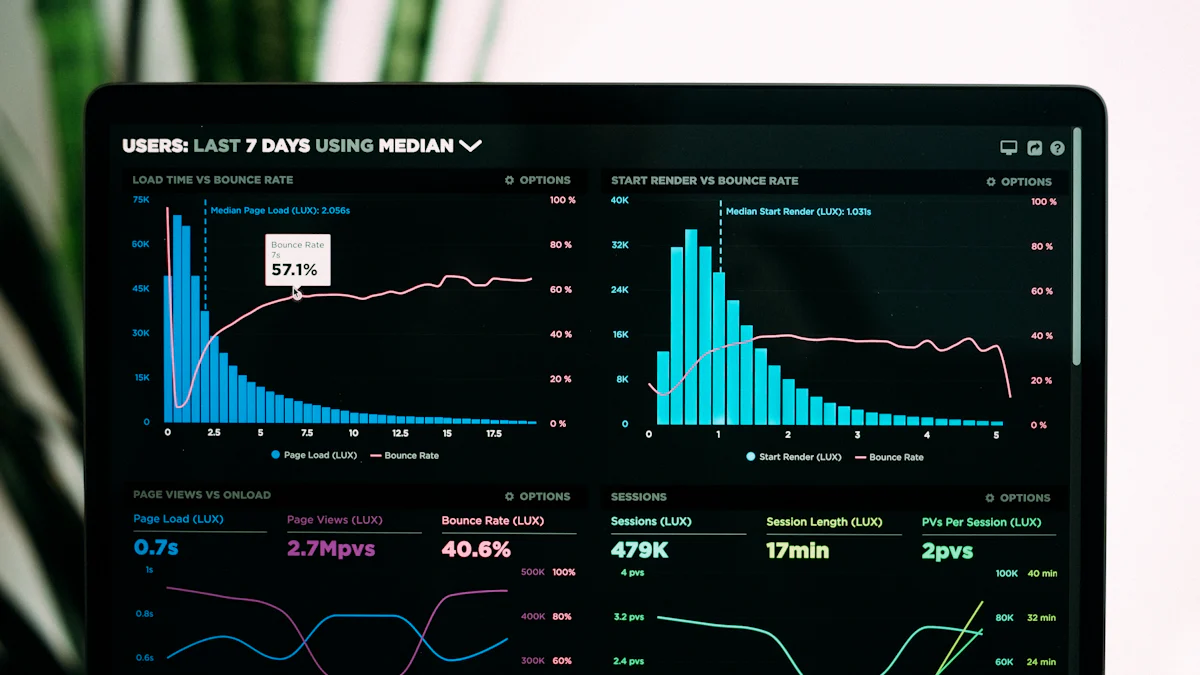Ad performance monitoring holds significant importance in digital marketing. Marketers need to track engagement, conversion rates, and other metrics to optimize campaigns. Traditional methods often face challenges such as delayed data and inaccurate insights. Real-Time Data Processing offers a solution by enabling immediate analysis and decision-making. This approach allows marketers to capitalize on opportunities and enhance customer experiences instantly.
Understanding Real-Time Data Processing
Definition and Key Concepts
What is Real-Time Data Processing?
Real-Time Data Processing refers to the immediate processing of data as soon as it becomes available. This method allows organizations to analyze and act on data without delay. The primary goal involves minimizing latency between data generation and actionable insights.
Key Components of Real-Time Data Processing Systems
Real-Time Data Processing systems consist of several critical components. Data ingestion captures incoming data streams from various sources. Data processing engines then transform raw data into meaningful information. Storage solutions provide temporary or long-term data retention. Visualization tools present processed data in an understandable format.
Technologies Enabling Real-Time Data Processing
Streaming Data Platforms
Streaming Data Platforms facilitate continuous data flow. These platforms handle high-velocity data streams efficiently. Apache Kafka and Amazon Kinesis serve as popular examples. These technologies ensure seamless data transmission and processing.
In-Memory Computing
In-Memory Computing enhances processing speed by storing data in RAM. This approach reduces access time compared to traditional disk-based storage. Apache Ignite and Redis are notable in-memory computing solutions. These tools support rapid data retrieval and manipulation.
Real-Time Analytics Tools
Real-Time Analytics Tools enable instant data analysis. These tools provide real-time dashboards and automated reporting features. Examples include Tableau and Google Data Studio. These analytics solutions help users make informed decisions quickly.
Benefits of Real-Time Data Processing for Ad Performance Monitoring
Immediate Insights and Actions
Faster Decision Making
Real-Time Data Processing enables marketers to make swift decisions. Immediate data analysis provides up-to-date insights into ad performance. This rapid feedback loop allows for quick adjustments to campaigns. Marketers can identify trends and respond to them without delay. This agility enhances the effectiveness of marketing strategies.
Real-Time Campaign Adjustments
Real-Time Data Processing allows for on-the-fly campaign modifications. Marketers can tweak ad content, targeting, and budgets based on current data. This flexibility ensures that campaigns remain relevant and engaging. Real-time adjustments help in maximizing the return on investment (ROI). Continuous optimization leads to better overall campaign performance.
Enhanced Accuracy and Precision
Reduced Data Latency
Real-Time Data Processing minimizes the delay between data generation and analysis. Reduced latency ensures that insights are based on the most recent data. This timeliness improves the accuracy of performance metrics. Marketers can trust the data to reflect the current state of their campaigns. Accurate data leads to more informed decision-making.
Improved Data Quality
Real-Time Data Processing enhances the quality of collected data. Continuous monitoring helps in identifying and correcting errors promptly. High-quality data provides a reliable foundation for analysis. Marketers can base their strategies on precise and accurate information. Improved data quality contributes to more effective ad performance monitoring.
Cost Efficiency
Optimized Resource Allocation
Real-Time Data Processing optimizes the allocation of marketing resources. Marketers can identify underperforming ads and reallocate budgets accordingly. This efficient use of resources reduces unnecessary expenditures. Optimized resource allocation leads to better financial outcomes. Marketers can achieve more with the same or even reduced budgets.
Reduced Wastage
Real-Time Data Processing helps in minimizing wastage in ad campaigns. Continuous monitoring identifies ineffective strategies early on. Marketers can discontinue or adjust these strategies to prevent further losses. Reduced wastage ensures that marketing efforts are focused on productive activities. This efficiency translates to higher profitability for businesses.
Implementing Real-Time Data Processing in Ad Performance Monitoring
Setting Up the Infrastructure
Choosing the Right Tools and Platforms
Selecting appropriate tools and platforms is crucial for effective Real-Time Data Processing. Amazon Kinesis Data Streams offers a scalable solution capable of capturing gigabytes of data per second from numerous sources. Amazon Managed Service for Apache Flink provides real-time data transformation and analysis using the open-source framework Apache Flink. These tools ensure efficient data handling and processing.
Integrating with Existing Systems
Integrating Real-Time Data Processing systems with existing infrastructure requires careful planning. Compatibility with current databases, data warehouses, and analytics tools must be ensured. Amazon Data Firehose facilitates seamless integration by capturing, transforming, and loading data streams into AWS data stores. This integration enables near real-time analytics with existing business intelligence tools.
Data Collection and Integration
Real-Time Data Sources
Identifying reliable real-time data sources is essential for accurate ad performance monitoring. Common sources include social media platforms, website analytics, and customer interaction data. Stream Ingestion services can capture continuous data from thousands of devices securely. These sources provide a steady stream of valuable data for analysis.
Data Integration Techniques
Effective data integration techniques enhance the quality and usability of collected data. Techniques such as data normalization, deduplication, and real-time ETL (Extract, Transform, Load) processes are vital. These methods ensure that data from various sources is consistent and ready for immediate analysis. Proper integration techniques reduce errors and improve data reliability.
Analyzing and Visualizing Data
Real-Time Dashboards
Real-time dashboards offer an intuitive way to monitor ad performance metrics. These dashboards display up-to-date information, allowing marketers to track engagement, conversion rates, and other key metrics instantly. Tools like Tableau and Google Data Studio provide customizable dashboards that present data in a clear and actionable format. Real-time visualization aids in quick decision-making and strategy adjustments.
Automated Reporting
Automated reporting streamlines the process of generating insights from real-time data. Reports can be scheduled to run at regular intervals, providing continuous updates on ad performance. Automated reporting tools reduce manual effort and ensure timely delivery of insights. This automation enhances the efficiency of Real-Time Data Processing and allows marketers to focus on strategic tasks.
Case Studies and Real-World Examples
Successful Implementations
Case Study 1: E-commerce Platform
An e-commerce platform implemented Real-Time Data Processing to enhance ad performance monitoring. The platform integrated streaming data platforms like Apache Kafka to capture user interactions and purchase data. In-memory computing solutions such as Redis enabled rapid data retrieval and manipulation. Real-time analytics tools provided immediate insights into customer behavior and ad performance.
The platform achieved several key outcomes:
- Increased Conversion Rates: Real-time adjustments to ad campaigns based on current data led to higher conversion rates.
- Optimized Ad Spend: Continuous monitoring and quick decision-making reduced wastage and optimized resource allocation.
- Enhanced Customer Experience: Immediate insights allowed for personalized and timely ad content, improving customer engagement.
Case Study 2: Social Media Campaign
A social media campaign utilized Real-Time Data Processing to monitor ad performance. The campaign used Amazon Kinesis Data Streams to handle high-velocity data from user interactions. Amazon Managed Service for Apache Flink transformed and analyzed the data in real time. Real-time dashboards provided by Tableau displayed up-to-date metrics, enabling swift campaign adjustments.
Key achievements included:
- Improved Engagement: Real-time data analysis helped identify trending topics and adjust content accordingly, boosting user engagement.
- Cost Efficiency: The ability to discontinue underperforming ads promptly resulted in significant cost savings.
- Accurate Performance Metrics: Reduced data latency ensured that performance metrics reflected the current state of the campaign, leading to more informed decisions.
Lessons Learned and Best Practices
Key Takeaways from Case Studies
The case studies highlight several important lessons:
- Immediate Insights Drive Success: Real-Time Data Processing provides immediate insights that drive successful ad campaigns.
- Integration is Crucial: Seamless integration with existing systems ensures efficient data handling and processing.
- Customization Enhances Effectiveness: Customizable real-time dashboards and automated reporting tools enhance the effectiveness of data analysis.
Recommendations for Future Implementations
Future implementations of Real-Time Data Processing should consider the following recommendations:
- Choose Scalable Solutions: Select scalable tools and platforms like Amazon Kinesis and Apache Kafka to handle large volumes of data.
- Ensure Data Quality: Implement data integration techniques such as normalization and deduplication to maintain high data quality.
- Focus on User Experience: Use real-time insights to personalize ad content and improve user engagement.
Real-Time Data Processing plays a pivotal role in enhancing ad performance monitoring. This approach provides immediate insights and allows for swift adjustments to campaigns. Real-time analysis ensures accurate and timely data, which leads to better decision-making. The future of ad performance monitoring will likely see widespread adoption of Real-Time Data Processing due to its numerous benefits. Marketers should embrace this technology to optimize their strategies and achieve superior outcomes.






